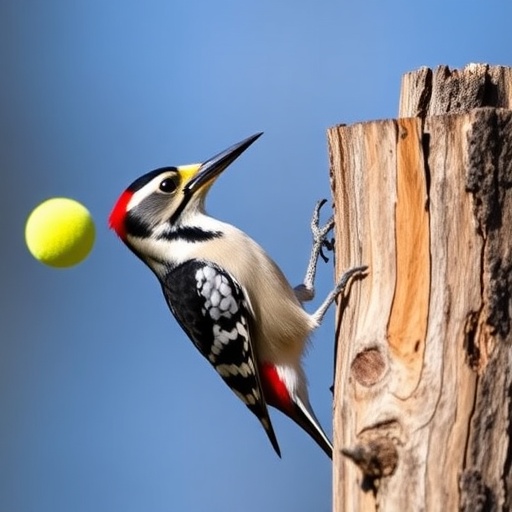Woodpeckers are nature’s relentless percussionists, known for their astonishing ability to hammer wood with tremendous force without apparent injury. Researchers at Brown University, along with collaborators from the University of Münster, have uncovered the intricate neuromuscular choreography these birds employ to turn themselves into living hammers. Published in the Journal of Experimental Biology, their groundbreaking study reveals how woodpeckers brace their entire bodies and synchronize their breathing to safely and efficiently deliver each powerful peck.
Woodpeckers endure extreme mechanical stresses, with decelerations reaching up to 400 g when their beaks collide with wood. To understand how these birds avoid brain injury and structural damage, the researchers focused on the downy woodpecker, a species adept at repeated drumming and drilling. By combining advanced high-speed videography and electromyography, which measures electrical muscle activity, the team dissected the precise timing and contribution of multiple muscle groups during hammering.
Their investigation began by capturing and observing eight wild downy woodpeckers over several days. Using high-speed cameras, the scientists documented every moment the birds drilled or tapped on a hardwood surface. Simultaneously, tiny electrodes recorded the electrical signals from muscles located in the head, neck, abdomen, tail, and legs, revealing the neuromuscular pattern underlying the woodpeckers’ hammer-like strikes.
The data showed that the hip flexor and front neck muscles play a major role in propelling the beak forward and generating impact force. These primary movers provide the explosive energy needed to drive the beak into tough wood surfaces. Supporting muscles at the base of the skull and along the neck brace the bird’s head, while the abdominal muscles stabilize the torso. Meanwhile, specialized tail muscles flex before impact and act as an anchor, stabilizing the bird’s hip and providing a solid fulcrum against the tree trunk.
This complex muscle engagement effectively transforms the woodpecker’s body into a rigid, hammer-like mechanism. By creating a firm, braced system from the head down through the tail, the woodpecker can safely transfer the immense momentum generated by its hip and neck muscles into each strike. The body’s rigidity helps distribute the enormous shock, preventing injury from the repetitive pounding.
In a fascinating twist, the study also uncovered that woodpeckers actively adjust the power of their strikes depending on the task. When drilling, which requires penetrating dense wood, the birds’ hip flexor muscles contract with greater force, boosting impact energy. Conversely, during softer tapping used for communication, these muscles ease their contraction, reducing the strike’s intensity. This modulation allows woodpeckers to communicate subtly without compromising their safety or wasting energy.
Another remarkable finding concerned the birds’ breathing patterns during hammering. The researchers recorded air pressure within the birds’ airways and measured airflow through the voice box. They discovered that, just at the moment of beak contact, woodpeckers exhale forcefully in a manner akin to a grunt. This synchronized breathing enhances the co-contraction of trunk muscles, effectively stiffening the body and augmenting the power of each blow.
This respiratory-muscular coordination is reminiscent of elite athletes who grunt as they exert maximal effort, stabilizing their core musculature and improving performance. However, unlike human grunts, the woodpecker’s vocalizations are drowned out by the rapid drumming noise, making this physiological adaptation “silent” to human observers.
Impressively, woodpeckers maintain this breathing-movement synchronization even during rapid tapping sequences, striking at rates up to 13 times per second. Between each strike, they inhale a brief breath lasting approximately 40 milliseconds, efficiently maintaining oxygen supply without disrupting their relentless pecking rhythm. This feat underscores an extraordinary integration of movement and respiration evolved for peak drilling efficiency.
The multi-faceted system revealed by this study highlights the remarkable evolutionary refinement woodpeckers have achieved to protect their brains and bodies while performing one of nature’s most challenging mechanical tasks. Through precise neuromuscular coordination, combined with finely tuned respiratory control, these birds masterfully generate and withstand tremendous forces that would incapacitate most other animals.
Furthermore, the insights gained from this research may inspire bioinspired robotic designs and impact-absorption technologies. By mimicking how woodpeckers distribute forces through rigid body bracing and muscle coordination, engineers might develop new materials or structures capable of withstanding repeated impacts without damage.
In conclusion, the study published in the Journal of Experimental Biology reveals that woodpecker drilling is not merely a matter of brute force; it is a symphony of neuromuscular coordination, biomechanical bracing, and synchronized breathing. From beak tip to tail, every part of the woodpecker’s body works in concert, transforming the bird into a living hammer that hammers hard without harm. This remarkable adaptation stands as a testament to nature’s ingenuity, offering fresh perspectives on both animal physiology and applied science.
Subject of Research: Animals
Article Title: Neuromuscular coordination of movement and breathing forges a hammer-like mechanism for woodpecker drilling
News Publication Date: 6-Nov-2025
Web References: https://journals.biologists.com/jeb, http://dx.doi.org/10.1242/jeb.251167
References: Antonson, N. D., Ogunbiyi, S., Champigneulle, M., Roberts, T. J., Goller, F., & Fuxjager, M. J. (2025). Neuromuscular coordination of movement and breathing forges a hammer-like mechanism for woodpecker drilling. Journal of Experimental Biology, 228, jeb251167. doi:10.1242/jeb.251167
Keywords: Woodpecker biomechanics, neuromuscular coordination, breathing synchronization, impact force, muscle activation, bioinspired design, motor control, animal physiology, high-speed videography, electromyography
Tags: avoiding brain injury in birdsbiomechanics of woodpeckersbird communication and soundsdowny woodpecker studyhigh-speed videography in wildlife researchimpact forces in bird anatomyimplications of woodpecker research in biologymuscle activity during drillingneuromuscular coordination in birdspercussion techniques in naturestructural adaptations of woodpeckerswoodpecker behavior





